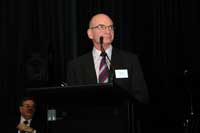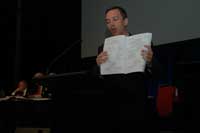Sydney Synod has voted without dissent to send the recommendations of the Archbishop's Strategic Commission on Structure, Funding and Governance to a working party.

With such a wide brief, covering the assets of the Endowment of the See, Diocesan investment policy and governance of the major boards, synod members struggled to understand the full ramifications of the commission’s work.
Pre-Synod briefings were well attended, but it still took more than an hour of explanation and questions before a vote was taken on what to do with the recommendations.
During the explanatory session, Commission members took questions on areas of their special expertise.
Property consultant Robert Freeman and the Chairman of the St Andrew’s House Corporation, Dr Laurie Scandrett fielded questions about the office tower and retail complex below. Valuers say St Andrew’s Arcade alone is worth more than 30 million dollars.
Mr Freeman said external managers had been appointed to the arcade and were fine-tuning the ‘retail mix’.
Dr Scandrett says although the last Synod had been told three floors of St Andrew’s House would be vacant by the time this October, heads of agreement had now been signed to fill the vacancies.
Another commission member, Businessman Simon Pillar was called upon to explain the ‘asset mix’ of diocesan investments.
He cited the Yale and Harvard Universities as world’s best practice in managing endowments.
Both of the Universities had managed to generate large yearly payments, as well as growing the real value of their funds.
One of the secrets to the success, Mr Pillar said, was a mix of assets including securities, real estate and other investments.
But while the universities had only around 10 percent of their funds in real estate, one diocesan fund had 37 percent in bricks and mortar.
Mr Pillar said diocesan funds were therefore “heavily overweighted to illiquid real estate assets.”
Commission Chairman Peter Kell proposed a working party, overseen by standing committee, to consider which of the commission’s recommendations should be implemented and how.
But, after questioning by several speakers, he assured Synod a parish levy was not being proposed and would have to be put to Synod if one were contemplated.
Likewise, sale of assets such as the Archbishop’s residence, Bishopscourt, would be a matter for Synod.

Mr Robert's amendment committed the Standing committee to including the views of major Diocesan bodies, such as the Glebe Board and the Property Trust, in the final report.
Other amendments were withdrawn and the final decision taken was that
Synod welcomes the report of the Archbishop's Strategic Commission on Structure, Funding and Governance together with the responses thereto of the GAB/SDS, the ACPT and SACS, and requests the Standing Committee to –
(a) undertake consideration of the possible ways in which –
(i) the concerns raised in the responses from the GAB/SDS, the ACPT and SACS may be addressed, and then
(ii) the recommendations may be implemented, and
(b) in the light of (a), pass such legislation as may be desirable or practicable, excluding any sale ordinance, or otherwise report to the next session of the Synod on any future proposals.
A motion to establish the working party will be on the agenda for the next Standing Committee meeting in November.















